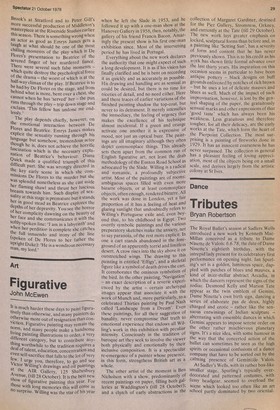Dance
Tributes
Bryan Robertson
The Royal Ballet's season at Sadlers Wells introduced a new work by Kenneth MacMillan conceived as a tribute to Dame Ninette de Valois: 6.6.78, the date of Dame Ninette's eightieth birthday, with the intrepid lady present for its celebratory first performance on opening night. Ian Spurling's set is a golden, luminous space, dappled with patches of blues and mauves, a kind of inter-stellar abstract Arcadia, in which the dancers represent the signs of the zodiac. Desmond Kelly and Marion Tate appear as the twin emblem of Gemini, Dame Ninette's own birth sign, dancing a series of elaborate pas de deux, highly charged and erotic — rather like the sensuous entwinings of Indian sculpture — _alternating with ensemble dances in which Gemini appears to impose serene order on the other rather mischievous planetary signs. It's a nice idea, with some humour in the way that the concerted action of the ballet can sometimes be seen as the high spirits or occasional confusions of a dance company that have to be sorted out by the calming presence of Gemini/de Valois.
At Sadler's Wells, with its rather box-like smaller stage, Spurling's typically overdecorated and patterned costumes, with fussy headgear, seemed to overload the scene which looked too often like an art school partly dominated by two oriental looking turbanned harlequins as the Gemini presence.
A short ballet by the young dancer and choreographer David Brintley, also a piece d'occasion, was a much more amusing tribute to Dame Ninette: Take Five, after Brubeck's famous cool jazz number, with Lynn Seymour strutting and high kicking in black fishnet tights and small black hat well down over her ears in the best Jeanmaire-Minelli tradition. Her four male companions nicely supported Seymour's high style: wit and brevity were perfectly matched.
The other outstanding events in tne opening nights of the season have included an immaculate revival of de Valois' own Rakes Progress (1935), supervised to great effect by its creator, and a refurbished production of Ashton's Les Patineurs (1937) in which William Chappell's delightful and historically important invention of an outdoor skating rink can at last be seen again in its original splendour. The dark greens, blues and browns of winter woods, the elegant white trellis-work arches that so perfectly frame the arrivals and departures of skaters humorously or romantically in motion under clumps of yellow lanterns, the Meyerbeer waltzes and polkas orchestrated in the best oompah style by Constant Lambert — all this makes one of the most enjoyable ballets in the repertoire. The set, lighting, and costumes in brown and blue with white trimming and French berets for the boys, the same hats with clusters of veiling perched at the back for the girls, all combine to make this one of the few ballets that could always be enjoyed anywhere in the world because it is visually in the finest Bakst — Benois tradition without lapsing into trivial pastiche. The company danced with appropriate verve and humour; Wayne Sleep injected fresh wit and energy into the role of the Blue Skater, the outsider showing off on the rink or tagging along behind the other skaters, left alone endlessly twirling in the centre of the stage as snow falls and the light dims. The Rake's Progress was brilliantly danced by the company, clearly relishing de Valois' vivid realisation of each character conspiring in the Rake's doom. Desmond Kelly was a perfect Rake, hell-bent on perdition from the first scene with the Tailor, Fencing Master and Musician, and Margaret Barbieri's Betrayed Girl kept the pathos of her role well in check through the poise and intelligence of her dancing. The work is quite undated in impact: de Valois has always had a flair for taut, unrhetorical and economic gesture in this mixture of mime and dance; Rex Whistler's cool sets and richly dark splashes of colour in the costumes remain a perfect foil to her drily forceful dramatic sense.
On other evenings, van Manen's Grosse Fuge has been sharply revived, and The Prodigal Son, with Rouault's sets looking a bit chalky and pallid but Maina Gielgud doing more than justice to the Siren; and MacMillan's early Solitaire (1956) and very adult study in children's games, with the girl continually left alone or deserted, too fussily designed by Barry Kaye. Marion Tate danced the main role ardently and brilliantly. The company, always touring and immensely hard working, danced well to packed houses all through the season: the Grosse Fuge displaying most impressively the effortlessly clean line and disciplined attack of eight of the Company's principal dancers. Conceived (in 1971) for four male and four female dancers, Van Manen's incisively strenuous choreography never trivialises the spirit of the Beethoven score.
The last main event of the season was Lynn Seymour's Intimate Letters, a dance drama usingJanacek's second string quartet and an occasional, and effective, sound collage by Bob Downes. Galina Samsova danced nobly and with great tenderness the complex role of the love-torn protagonist, caught between the conflicting pressures of husband, lover and children. The scene is set, richly by Georgiadis, at an informal concert in an affluently bohemian salon in which the performance of Janacek's music takes place as a recital, on stage. The music is great, the choreography always intelligent and pointed but the ballet seems over compacted and strenuous, like a truncated and bourgeois equivalent for Mayerling; above all it marks a return to detailed mime and acting when Seymour's development as a choreographer seems to need an extension into purer realms of abstract dance.







































 Previous page
Previous page